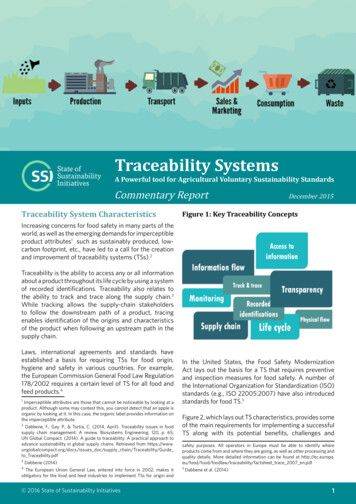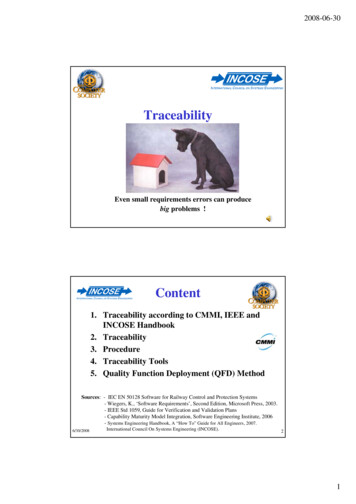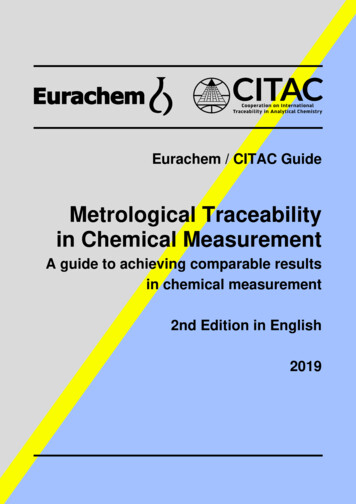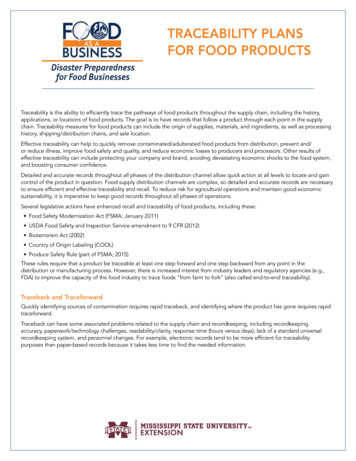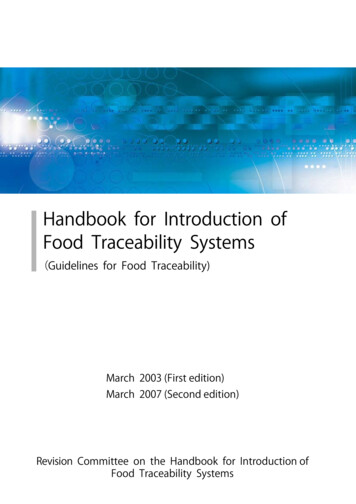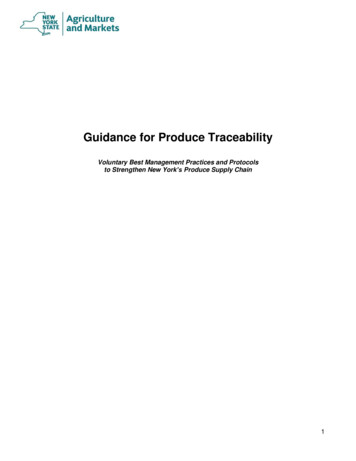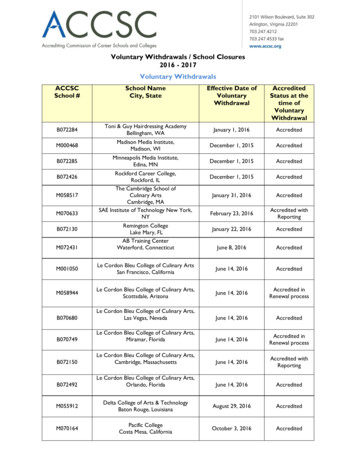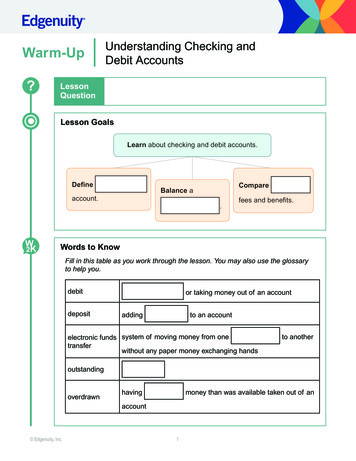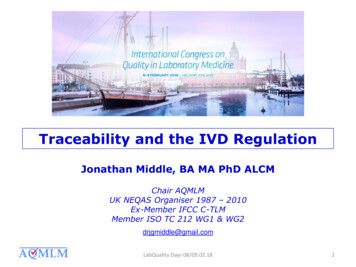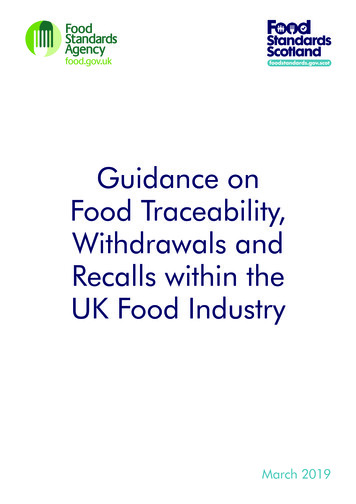
Transcription
Guidance onFood Traceability,Withdrawals andRecalls within theUK Food IndustryMarch 2019
For queries about this guidance, including if you require the information in an alternative formatsuch as audio, large print or Braille please contact:For Scotland:Email: incidents@fss.scotTel: 01224 285 138For England, Wales and Northern Ireland:Email: foodincidents@food.gov.ukTel: 020 7276 8448
SummaryIntended audienceFood business operators (FBOs) UK food enforcement authorities Which UK nations does thiscover?England, Wales, Scotland and Northern IrelandPurposeThe purpose of this guidance is to assist FBOs tocomply with food law and to provide guidance on roles,responsibilities and actions to take during food safetywithdrawals and recalls.Legal status:This guidance sets out the legal requirements ofRegulation (EC) No.178/2002 and associated foodlegislation. The guidance also includes best practiceguidance.Key words Review dateMarch 2020Food law Food withdrawals Food recalls Food safety TraceabilityGuidance on Food Traceability, Withdrawals and Recalls within the UK Food Industry1
Revision historyThis guidance follows the Government Code of Practice on Guidance. If you believethis guidance breaches the Code for any reason, please let us know by emailingbetterregulation@food.gov.uk. If you have any comments on the guidance itself,please call us using the contact number on page 2.RevisionNo.2RevisiondatePurpose of revision and paragraphnumberGuidance on Food Traceability, Withdrawals and Recalls within the UK Food IndustryRevised by
ContentsSummary1Revision history2Introduction5Intended audience5Purpose and scope of guidance6Legal status of guidance6EU Exit7Definitions7Traceability8Key steps in developing food traceability systemsMaking a decision to withdraw or recall foodPerforming a risk assessment91113Planning for a food withdrawal/recall14Initiating and managing a food withdrawal/recall14Information gathering15Notification procedures15Monitoring progress of a food withdrawal/recall16Handling of unsafe food16Roles and responsibilities of those involved in awithdrawal/recall19FBOs initiating a food withdrawal/recall20Non-retail FBOs receiving notification of a food withdrawal/recall21Retail FBOs receiving notification of a food withdrawal/recall (includingcatering businesses selling prepacked food)22Caterers receiving notification of a food withdrawal23Enforcement authorities23Primary and Home authorities (where applicable)24Central competent authorities (FSA and FSS)24Consumer, allergy and patient support organisations25Guidance on Food Traceability, Withdrawals and Recalls within the UK Food Industry3
Contents4Annexe A: Food Recalls Steering Group and Working Group Members26Annexe B: Definitions27Annexe C: Specific food traceability requirements30Annexe D: Example of microbiological risk assessment considerations32Annexe E: Planning for a food withdrawal/recall34Annexe E(i): Example contacts template37Annexe E(ii): Example food incident key decision log38Annexe F: Example template for notifying the enforcement authority39Annexe G: Business-to-business communications for food safety withdrawalsand recalls across the supply chain42Annexe H: Key principles and best practice template for accurate and effectiveconsumer recall notifications47Annexe I: Background to root cause analysis53Guidance on Food Traceability, Withdrawals and Recalls within the UK Food Industry
Introduction1 This guidance has been produced by the Food Standards Agency (FSA) with FoodStandards Scotland (FSS), in association with members of working groups and agoverning steering group, established as part of a UK project, to: develop comprehensive UK guidance to clarify the roles, responsibilities andexpectations of the key players involved in food withdrawals and recalls in the UK improve the accessibility and consistency of food recall information directed at consumers enhance business to business communications about food recalls and withdrawals and establish guidance on root cause analysis (RCA) procedures to be used by industry inthe event of food withdrawals and recalls2 It replaces the FSA Guidance Notes for Food Business Operators on Food Safety,Traceability, Product Withdrawal and Recall produced in 20071.3 Project group members included representatives from the food industry, trade bodies,consumer, allergy and patient support organisations and enforcement authorities (seeAnnexe A for membership).4 FBOs are responsible for the safety of the food which they produce, distribute, store orsell, in particular FBOs must: not place unsafe food on the market comply with food law in the production, distribution, storage and sale of food be able to trace the suppliers of their food and the business customers to whom theyhave supplied the food (i.e. one step back and one step forward) andremove unsafe food from the market should a food safety incident arise5 FBOs should therefore have adequate traceability and food withdrawal/recall systems inplace as part of their Food Safety Management System to fulfil these requirements. FBOsmay wish to seek advice from the enforcement authority with whom they are registered orapproved, and/or their Primary/Home authority for assurance that any system developedfor this purpose is appropriate and compliant.Intended audience6 The intended audience of this guidance is FBOs and UK food safety enforcementauthorities, as outlined in the definitions.1 document/fsa1782002guidance.pdfGuidance on Food Traceability, Withdrawals and Recalls within the UK Food Industry5
Purpose and scope of guidancePurpose and scope of guidance7 The purpose of this guidance is to support FBOs and UK food safety enforcementauthorities in establishing and implementing effective food withdrawal/recall systems torespond to food safety incidents. The guidance applies to all FBOs and aims to clarifyand, where appropriate, standardise procedures to identify and remove unsafe food fromthe market.8 The guidance outlines food law requirements and clarifies the roles, responsibilities andexpectations of the key stakeholders involved in the withdrawal/recall of unsafe food in the UK.9 The guidance sets out the requirements in relation to food safety incidents, in accordancewith Regulation (EC) No. 178/2002. It does not include animal feed (including pet food).However, FBOs may wish to adopt the principles within this guidance when dealing withnon-safety (non-compliant) related food, food contact materials, or animal feed (includingpet food) incidents.Legal status of guidance10 This guidance has been produced to explain the legal requirements of Regulation (EC)No.178/20022 in relation to food safety traceability, withdrawals and recalls and howcompliance may be achieved. Best practice guidance has also been included. You are notrequired by law to follow best practice guidance.11 The guidance is laid out in a format designed to allow businesses to consider theirprocesses and whether their current or proposed arrangements comply with food law. It islaid out in the following format: ‘The law’ – this quotes the relevant specific legal requirements. It is detailed at the startof the relevant section‘How to comply with the law’ – this outlines FSA and FSS guidance on how to comply withthe law. Businesses may take a different approach to achieve compliance with the law, butit is advisable to discuss any alternative approach with enforcement authorities in advance‘Best practice’ – this outlines examples of good practices that businesses may want toimplement. Businesses are not required by law to follow best practice. All guidance onbest practice is identified in boxes with a heading of Best Practice:Best PracticeAll best practice guidance is clearly identified within this document by this style of format.2 L/?uri CELEX:02002R0178-20180701&qid 1530528430965&from EN6Guidance on Food Traceability, Withdrawals and Recalls within the UK Food Industry
EU Exit12. This guidance should be read in conjunction with Regulation (EC) No. 178/2002, theFood Safety Act 19903, associated domestic food law legislation4, EU Food HygieneRegulations5, domestic food hygiene regulations6 and other specific legislation andguidance relating to food traceability and safety.13 Guidance on legal requirements in this document cannot cover every situation andFBOs may need to refer to the relevant legislation to see how it applies in any givencircumstance. FBOs with specific queries may wish to seek advice from their enforcementauthorities or seek their own legal advice.EU Exit14 References in this guidance to EU law should be read, where necessary, as references toretained EU law as amended under the European Union (Withdrawal) Act 2018.15 Guidance as to how that Act affects EU law is beyond the scope of this publication. FBOsand enforcement authorities are strongly encouraged to seek independent legal adviceabout their rights and obligations in connection with the Act, and EU Exit generally.Definitions16 A list of definitions of the key terms used throughout this guidance is provided in Annexe B.3 nts. Equivalent legislation in NI is The Food Safety (NI) Order1991 – ts/made4 The General Food Law Regulations 2004 in Scotland and Wales – nts/made the Food Safety and Hygiene (England) Regulations 2013 in England – ule/9/made and the General Food Regulations (NI) 2004 in NI – nts/made5 Regulation (EC) No.s 852/2004 – /?uri CELEX:02004R085220090420&qid 1545304105490&from ENRegulation (EC) No. 853/2004 – /?uri CELEX:02004R0853-20171121&qid 1545304143432&from ENRegulation (EC) No. 854/2004 – /?uri CELEX:02004R0854-20170101&qid 1545304202861&from ENRegulation (EC) No. 2073/2005 – /?uri CELEX:02005R2073-20180101&qid 1545304256862&from EN6 The Food Safety and Hygiene (England) Regulations 2013 – http://www.legislation.gov.uk/uksi/2013/2996,the Food Hygiene (Wales) Regulations 2006 – http://www.legislation.gov.uk/wsi/2006/31/made, the FoodHygiene Regulations (Northern Ireland) 2006 – /made and theFood Hygiene (Scotland) Regulations 2006 – madeGuidance on Food Traceability, Withdrawals and Recalls within the UK Food Industry7
TraceabilityThe lawLegalrequirements:Article 18 ofRegulation (EC)No. 178/2002The traceability of food, food-producing animals, and any othersubstance intended to be, or expected to be, incorporated into afood shall be established at all stages of production, processingand distribution.Food business operators shall be able to identify any person fromwhom they have been supplied with a food, , a food-producinganimal, or any substance intended to be, or expected to be,incorporated into a food . To this end, such operators shall have inplace systems and procedures which allow for this information to bemade available to the competent authorities on demand.Food business operators shall have in place systems andprocedures to identify the other businesses to which their productshave been supplied. This information shall be made available to thecompetent authorities on demand.Food which is placed on the market or is likely to be placedon the market in the Community shall be adequately labelledor identified to facilitate its traceability, through relevantdocumentation or information in accordance with the relevantrequirements of more specific provisions.How to comply with the law17 Each segment of the supply chain must be able to trace all the foods received by them andsupplied by them (one step back and one step forward). This will include being able totrace, as required, the ingredients used to produce finished products.18 In relation to food law, food retailers, including caterers, are not required to keeptraceability information relating to sales to the final consumer (since consumers are notfood businesses). Where a retailer knows that it is supplying directly to another foodbusiness, e.g. a catering outlet, traceability requirements must be adhered to.19 Business actions necessary to comply with the law will depend on the individual businessactivities, and what is achievable for the business, but effective traceability allowsfor effective and efficient corrective actions to be taken should a food safety incidentoccur. It enables FBOs to target any withdrawals and/or recalls, to give information toenforcement authorities and can help minimise the level of disruption and scale of thewithdrawal/recall to the business.8Guidance on Food Traceability, Withdrawals and Recalls within the UK Food Industry
Traceability7Key steps in developing food traceability systemsStep 1. The systemThe FBO’s system must be able to trace food purchased from suppliers and sold tobusiness customers (this does not include food that is sold directly to the consumer).Step 2. Defining batches of foodDefining batches of food is essential for good traceability and may help limit theamount of food to be withdrawn/recalled. In the event of a food safety incident,Regulation (EC) No. 178/2002 considers a whole batch, lot or consignment unsafeunless it can be demonstrated otherwise.Step 3. Traceability informationTraceability information for food one step back and one step forward in the supplychain is required by law. The following information should be available:name and address of supplier/business customer (food retailers, includingcaterers, are notrequired to keep traceability information relating to sales to the final consumer)details of product, to enable its identification, and quantity in which suppliedthe date of the transaction and deliveryFBOs may choose to keep raw materials in their original packaging to enableretrieval of traceability information.In addition to the above, all FBOs that handle products of animal origin (POAO) orsprouted seeds must also comply with more specific food traceability requirements7.These are outlined in Annexe C.Step 4. Record keepingTo ensure that an effective withdrawal/recall can be implemented in the event of afood safety incident, FBOs must have systems in place which allows traceabilityinformation to be made available.Traceability information can be found on a variety of documents, including invoices,delivery documents or receipts. FBOs should keep this information in a way thatmakes it easy to check back to see where a product came from and forward tocheck who has been supplied. Records are not required where the food is supplieddirectly to the consumer.Where accurate information can be retrieved quickly it may help minimise the scaleof the withdrawal/recall and the impact on public health.It is for FBOs to determine how long they need to keep traceability informationunless specific food regulations state a defined period. The period should beappropriate for the nature and product life span of the food, and the circumstancesunder which they may be required to produce traceability information.7 Commission implementing Regulation (EU) No 931/2011 d 1540286809065&uri CELEX:32011R0931. Commission Implementing Regulation (EU) No /TXT/?qid 1540286887876&uri CELEX:32013R0208Guidance on Food Traceability, Withdrawals and Recalls within the UK Food Industry9
TraceabilityBest PracticeThe system It is recommended that FBOs confirm that the suppliers that they trade with also haveeffective traceability systems and procedures in placeTraceability information Additional information, such as internal process traceability enables better visibility ofthe FBO’s whole supply chain. Internal traceability systems can assist FBOs in quicklyidentifying how raw materials and ingredients are stored, used and handled once onsite. Examples of process traceability information include:––identification of a product batch––application of a unique batch code identifier to all packs of that particular batch andinternal documentation––recording of batch codes of all ingredients used in the production of that batch ofproduct––recording of production and quality information relating to the product batch –examples include: product name product batch code date of production time of start and end of production (where appropriate) product size food contact packaging number of packs per case number of cases linking the product batch code to all raw materials used in its productionRecord keeping Unless there are legal requirements on the minimum period traceability informationmust be kept, it is best practice to maintain traceability information on pre-packed foodsfor the shelf life of the food plus 12 months as a minimum. Traceability requirementsfor foods pre-packed for direct sale, loose foods and foods served as a meal should beconsidered on a case by case basis, in consultation with the enforcement authorityReview of traceability systems 10Periodic review of business practices will help ensure that traceability systems remaineffective, and that information can be provided in a timely manner. FBOs may wish tocarry out a periodic review of their practices. Traceability systems should be reviewedat least on an annual basis, or sooner if there has been a significant change withina business e.g. change of supplier. It is recommended that checks are carried out onsupplier and business customer traceability (customer traceability is not required forFBOs selling directly to consumers)Guidance on Food Traceability, Withdrawals and Recalls within the UK Food Industry
Making a decision to withdraw or recall foodMaking a decision to withdraw orrecall foodThe lawLegalrequirements:Articles 14 and19 ofRegulation (EC)No. 178/2002Food shall not be placed on the market if it is unsafe.In determining whether any food is unsafe, regard shall be had:(a) t o the normal conditions of use of the food by the consumer andat each stage of production, processing and distribution, and(b) t o the information provided to the consumer, includinginformation on the label, or other information generallyavailable to the consumer concerning the avoidance of specificadverse health effects from a particular food or category offoods.In determining whether any food is injurious to health, regard shallbe had:(a) n ot only to the probable immediate and/or short-term and/or long-term effects of that food on the health of a personconsuming it, but also on subsequent generations;(b) to the probable cumulative toxic effects;(c) t o the particular health sensitivities of a specific category ofconsumers where the food is intended for that category ofconsumers.In determining whether any food is unfit for human consumption,regard shall be had to whether the food is unacceptable forhuman consumption according to its intended use, for reasonsof contamination, whether by extraneous matter or otherwise, orthrough putrefaction, deterioration or decay.If a food business operator considers or has reason to believe that afood which it has imported, produced, processed, manufactured ordistributed is not in compliance with the food safety requirements,it shall immediately initiate procedures to withdraw the food inquestion from the market where the food has left the immediatecontrol of that initial food business operator and inform thecompetent authorities thereof. Where the product may havereached the consumer, the operator shall effectively and accuratelyinform the consumers of the reason for its withdrawal, and ifnecessary, recall from consumers products already supplied to themwhen other measures are not sufficient to achieve a high level ofhealth protection.Guidance on Food Traceability, Withdrawals and Recalls within the UK Food Industry11
Making a decision to withdraw or recall foodHow to comply with the law20 In the event of a food incident, where the food has left the immediate control of thebusiness, FBOs are required to determine if the food is unsafe and whether a withdrawaland/or recall is necessary.21 The decision tree below outlines a process for establishing if food is unsafe and thenecessary actions to take. Businesses are required to inform their enforcement authoritywhere they consider or have reason to believe that the food is unsafe, and so they shouldhave open dialogue with their enforcement authority during this process.Is it clearfrom foodsafety regulationsthat the food isunsafe?YesNoCarry out riskassessment*Action awithdrawalYesHas thefood reachedconsumers?NoRecall notrequiredIs the foodunsafe or likely tobe unsafe?YesNoIs awithdrawalsufficient to protectpublic health?YesRecall notrequiredWithdrawal/recall notrequiredNoAction arecall*12Where food has not been produced, handled, processed or stored in accordance with food safety legislation the riskassessment should take this into consideration when determining if the food is, or likely to be, unsafe.Guidance on Food Traceability, Withdrawals and Recalls within the UK Food Industry
Making a decision to withdraw or recall foodPerforming a risk assessment22 In some cases, FBOs may be able to easily identify that a food is unsafe due to theexceedance of specified food safety regulatory limits. However, not all hazards that mightbe found in food are specified in food safety regulations, for example, contamination offood from foreign objects (e.g. glass). The key is that once a hazard of any kind has beenidentified in food, FBOs should assess the risk it presents to consumers.23 The assessment of the associated risk should take into account the factors in Article 14of Regulation (EC) No. 178/2002.24 FBOs are responsible for carrying out risk assessments and making decisions regardingthe safety of the food. Technical expertise may be required in carrying out a riskassessment to understand the hazards involved and the adverse effects that can ariseif consumed. FBOs may need to seek advice from technical experts or work with theirenforcement authority to either verify their risk assessment or determine the informationneeded and steps necessary to carry out an effective assessment.25 A risk assessment should include the following: hazard identification: identifying known or potential health effects associated with aparticular foodhazard characterisation: the qualitative and/or quantitative evaluation of the nature ofthe adverse effectexposure assessment: the qualitative and/or quantitative evaluation of the likely intakeof the particular food andrisk characterisation: the integration of hazard identification, hazard characterisationand exposure assessment to estimate the risk and its associated uncertainties26 As part of the risk assessment, consideration should be given to the intended use of thefood, e.g. it is ready to eat, the target consumer group of the food and the potential riskand sensitivities associated with that group in consuming that food.27 An example of considerations for completing a risk assessment is outlined in Annexe D.Best PracticeRisk assessment Record the outcomes from a risk assessment, the decisions made, and actions takenalong with supporting information.Guidance on Food Traceability, Withdrawals and Recalls within the UK Food Industry13
Planning for a food withdrawal/recallPlanning for a food withdrawal/recall28 There are a number of actions that often need to be carried out simultaneously duringa food withdrawal/recall, so advance planning is essential. An example of how a foodbusiness can plan for a food withdrawal/recall is outlined in Annexe E.Initiating and managing a foodwithdrawal/recallThe lawLegalrequirements:Article 19 ofRegulation (EC)No. 178/2002If a food business operator considers or has reason to believe that afood which it has imported, produced, processed, manufactured ordistributed is not in compliance with the food safety requirements,it shall immediately initiate procedures to withdraw the food inquestion from the market where the food has left the immediatecontrol of that initial food business operator and inform thecompetent authorities thereof. Where the product may havereached the consumer, the operator shall effectively and accuratelyinform the consumers of the reason for its withdrawal, and ifnecessary, recall from consumers products already supplied to themwhen other measures are not sufficient to achieve a high level ofhealth protection.A food business operator shall immediately inform the competentauthorities if it considers or has reason to believe that a food whichit has placed on the market may be injurious to human health.Operators shall inform the competent authorities of the actiontaken to prevent risks to the final consumer How to comply with the law29 Where it is necessary to initiate a food withdrawal/recall there are a number of keyaspects that need to be considered to manage the process, such as those outlined below.14Guidance on Food Traceability, Withdrawals and Recalls within the UK Food Industry
Initiating and managing a food withdrawal/recallInformation gathering30 Gathering information regarding the food safety incident, including details of the food,the nature of the hazard and the extent of the problem is important so that effective riskmanagement decisions can be made.31 This information can come from a variety of sources, both internal and external, including: production records sales records employees suppliers business customers audit sampling analysis complaints and enforcement authoritiesNotification procedures32 When FBOs initiate a food withdrawal/recall due to food safety issues, it must becommunicated as soon as possible to be effective. A written plan for carrying out awithdrawal/recall will help ensure effective action is taken.33 FBOs must notify: their enforcement authorities and the FSA/FSS their suppliers and business customers (including brand owners) consumers (only in the case of a recall)Notification to enforcement authorities and FSA/FSS34 FBOs are required to notify their enforcement authority and FSA/FSS of a food safetyincident if they believe that they have placed food on the market that may be unsafe.This notification information is outlined in a communication template in Annexe Fwhich can be used by FBOs for notifying enforcement authorities.35 Established reporting mechanisms should be used when notifying FSA8/FSS9.36 Notification should not be delayed. If all the information is not readily available, providewhat details are available.Notification to suppliers and business customers37 FBOs must notify suppliers, where implicated, and affected business customers (including brandowners) of the food incident and the actions to be taken in handling the affected food (e.g.8 http://incidents.foodapps.co.uk/login.aspx9 nce on Food Traceability, Withdrawals and Recalls within the UK Food Industry15
Initiating and managing a food withdrawal/recallreturn or disposal). Procedures should be set up to outline methods of communication to ensurethat unsafe food is removed from the supply chain and recalled from consumers if necessary.Guidance for FBOs on trade to trade communications is outlined in Annexe G.Notification to consumers38 Information provided to consumers should be accurate and the communication methodeffective in informing them of the food recall and action to take. See Annexe H for keyprinciples and best practice templates that may be used when communicating with consumers.Monitoring progress of a food withdrawal/recall39 Communication should be maintained between FBOs, enforcement authorities andbusiness customers throughout the incident.Handling of unsafe food40 After a food withdrawal/recall, FBOs may have to deal with unsafe food.41 To ensure the control of food deemed unsafe, FBOs should consider the following: storing unsafe food away from non-affected food in a quarantined area labelling of quarantined food and maintaining accurate traceability and disposal records of recovered unsafe foodMaking unsafe food safe42 It may be possible for FBOs to re-work or re-label unsafe food that makes it safe andcompliant with food law, e.g. re-labelling a product with correct allergen information.FBOs must seek agreement from their enforcement authority before any food that hasbeen previously recalled or withdrawn is re-worked or re-labelled.Disposal of unsafe food43 If it is not possible to make the unsafe food safe, it must be treated as food waste. If theunsafe food contains POAO, FBOs should deal with it in accordance with the AnimalBy-Product Regulations10 or other relevant waste disposal legislation. FBOs should haveregard to any required certification that needs completing.44 For more information on the disposal of waste, FBOs may wish to seek advice from therelevant waste enforcement body11 or their waste contractor.10 Regulation (EC) No. N/TXT/PDF/?uri CELEX:02009R1069-20140101&from EN11 Animal and Plant Health Agency (APHA) and Local Authorities in England and Wales, DAERA in NI and SEPA inScotland.16Guidance on Food Traceability, Withdrawals and Recalls within the UK Food Industry
Initiating and managing a food withdrawal/recallBest PracticeNotification procedures Consumer, allergy and patient support organisations maintain contact details for vulnerableindivid
Email: foodincidents@food.gov.uk. Tel: 020 7276 8448. . Planning for a food withdrawal/recall 14 Initiating and managing a food withdrawal/recall 14. Information gathering 15 . Annexe E(i): Example contacts template 37 Annexe E(ii): Example food incident key decision log 38


